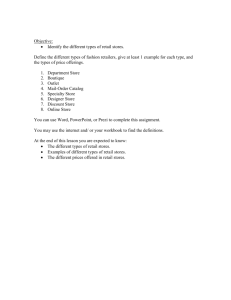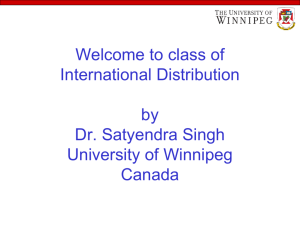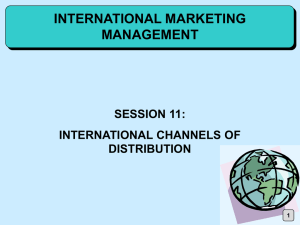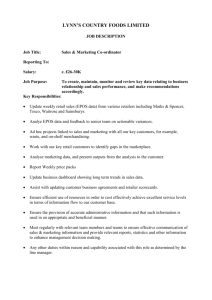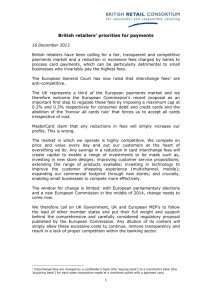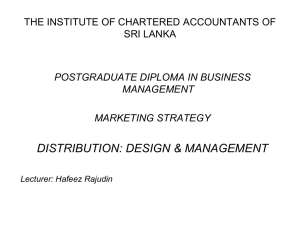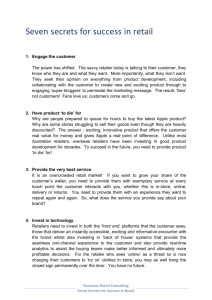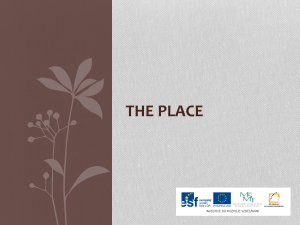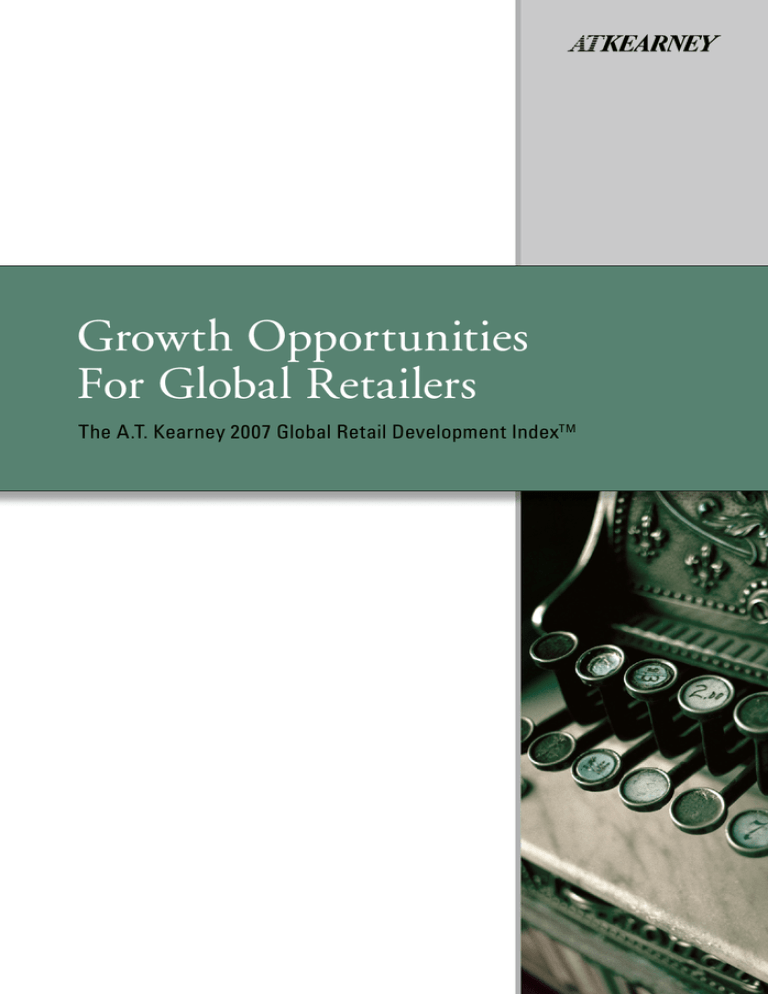
Growth Opportunities
For Global Retailers
The A.T. Kearney 2007 Global Retail Development IndexTM
G
lobal retail is experiencing an explosive modernization as investment rushes into developing markets. From small proprietors with
a mainly local focus, retail’s ambitions now stretch worldwide,
embracing the latest trends in marketing, distribution and supply. Modern
retail grew between 25 and 30 percent in India and 13 percent in both China
and Russia. As the wealthiest markets mature, more retailers are pursuing new growth opportunities. They are eyeing countries new to modern
retailing, smaller cities (as larger cities become saturated), and customer
segments hungry for specialty products. Retailers that can identify the
most promising markets will become fierce global competitors—able to
saturate the obvious markets and gain first-mover advantage in new ones.
Retailers understand these new realities. Modern
retail has been expanding to new markets for a
few years now. The trouble is, it is difficult to
determine which new market is the most promising one. As one market becomes saturated, is
it enough simply to follow the crowd into the
next one?
With this in mind, A.T. Kearney developed
the Global Retail Development IndexTM (GRDI).
Now in its sixth year, the GRDI identifies
windows of opportunity to help retailers make
strategic investments in exciting new markets.
It ranks the top 30 emerging countries for retail
development using 25 macroeconomic and retailspecific variables (see sidebar: About the Global
Retail Development Index on page 4). Figure 1 on
page 2 highlights the 2007 findings.
India, Russia and China continue to top
the Index. Retailers moved from talking about
expansion plans to acting on them in top cities.
Woolworth’s, Wal-Mart, Supervalu, Euroset and
Starbucks all have plans for entering India, joining a handful of single-brand retailers that are
already there, including Lacoste, Chanel, Swatch
and Omega. In China, the action spreads from
tier-one to tier-two cities, where a proliferation of modern retail has begun. Wal-Mart, for
example, opened a store in second-tier city Yuxi.
This year’s GRDI also indicates that several other
countries, including United Arab Emirates (UAE)
and Vietnam, are cracking open their windows
of opportunity in meaningful ways.
Of course, there is more to entering a new
market than knowing which cities are hot and
A.T. Kearney
|
Growth Opportunities for Global Retailers
1
Figure 1
The 2007 Global Retail Development IndexTM
2007
rank
Country
Region
Country
risk
Market
attractiveness
Market
saturation
Time
pressure
Weight
25%
25%
30%
20%
GRDI
score
1
India
Asia
67
42
80
74
92
2
Russia
Eastern Europe
62
52
53
90
89
3
China
Asia
75
46
46
84
86
4
Vietnam
Asia
57
34
76
59
74
5
Ukraine
Eastern Europe
41
43
44
88
69
6
Chile
Americas
80
51
42
43
69
7
Latvia
Eastern Europe
77
32
21
86
68
8
Malaysia
Asia
70
44
46
54
68
9
Mexico
Americas
83
58
33
33
64
Saudi Arabia
Mid. East/N. Africa
65
40
66
35
64
11
Tunisia
Mid. East/N. Africa
60
33
77
37
64
12
Bulgaria
Eastern Europe
62
32
42
68
63
13
Turkey
Mid. East/N. Africa
52
50
57
43
62
14
Egypt
Mid. East/N. Africa
43
37
85
35
61
15
Morocco
Mid. East/N. Africa
59
33
70
37
60
16
Thailand
Asia
71
39
30
55
59
17
Slovenia
Eastern Europe
100
33
13
47
58
18
United Arab Emirates
Mid. East/N. Africa
100
35
33
24
57
19
Croatia
Eastern Europe
73
38
10
70
56
20
Brazil
Americas
53
61
59
18
56
21
Uruguay
Americas
35
41
65
49
56
22
Peru
Americas
42
34
79
34
55
23
Philippines
Asia
41
46
63
37
54
24
Indonesia
Asia
36
40
70
37
52
25
Algeria
Mid. East/N. Africa
25
30
90
35
51
26
10
96
36
2
46
51
Romania
Eastern Europe
60
31
22
66
50
28
Lithuania
Eastern Europe
75
33
17
54
50
29
Argentina
Americas
31
50
43
54
50
30
Colombia
Americas
44
50
52
26
47
0 = high
risk
100 = low
risk
0 = low attractiveness
100 = high attractiveness
0 = saturated
On the radar screen
To consider
Lower
priority
Legend
Eastern Europe
Key
Hungary
27
Sources: Euromoney, World Bank, Global Competitiveness Report 2005-2006, A.T. Kearney analysis
2
Growth Opportunities for Global Retailers
|
A.T. Kearney
100 = not
saturated
0 = no time
pressure
100 = urgency
to enter
which ones are not. Our findings further emphasize the importance of understanding the timing
of market entry, particularly in terms of consumer
readiness. The market might be ripe, but are consumers open to new ideas and willing to accept
new products, formats and a “new way of shopping?” There are also significant challenges in
entering second- and third-tier cities versus firsttier cities. Retailers soon learn that there’s a world
of difference between opening a store in Yuxi and
opening one in Beijing.
Before we present the GRDI’s detailed regional
and country results, let’s look at how the findings can help retailers identify promising markets.
From our analysis, there are three factors that,
taken together, can mean the difference between
success and failure in a new market. They are:
gauging the window of opportunity for entering
key cities, understanding consumer readiness, and
knowing when and how to move into second- and
third-tier cities.
Gauging the Window of Opportunity
The “window of opportunity” measurement we
introduced last year continues to be crucial this
year. Countries typically progress through four
stages — opening, peaking, declining and closing — as they evolve from emerging to mature
markets, usually over the course of five to 10
years (see figure 2).
Figure 2
Window of opportunity analysis
Opening
Peaking
Declining
Closing
Russia (2007)
China (2003)
China (2007)
Vietnam (2006)
Malaysia (2007)
Ukraine (2007)
India (2007)
Hungary (2003)
Russia (2004)
India (2003)
Bulgaria (2007)
Slovakia (2003)
Malaysia (2006) Hungary (2004)
Slovakia (2005)
Ukraine (2004)
Vietnam (2003)
Bulgaria (2003)
High priority
GRDI
ranking
China (1995)
Hungary (2006)
Slovakia (2007)
India (1995)
Hungary (1995)
Kazakhstan (2006)
Low priority
Action
Monitor market
Open local office (sourcing, research),
test the market and learn
Expedite
implementation
No pattern identified
Format
of entry
Not applicable
Consider cash-and-carry or convenience
formats apart from supermarket
Introduce discount
and hypermarkets
Tailor formats to meet
specific consumer needs
at work
Labor
strategy
Not required
Hire and send expatriate employees
to location
Scale up operations,
increase local hiring,
participate in community
No pattern identified
Source: A.T. Kearney
A.T. Kearney
|
Growth Opportunities for Global Retailers
3
About the Global Retail Development Index
The annual A.T. Kearney Global
Retail Development Index ranks
30 emerging countries on a 100point scale — the higher the ranking,
the more urgency there is to enter
a country. Countries were selected
from a list of 185 based on three
criteria:
• Country risk: more than 35 in
Euromoney’s country-risk score
• Population size: more than two
million
• Wealth: GDP per capita more than
$3,000 (GDP per capita for countries with populations of more than
35 million is more flexible due to
the market opportunity)
GRDI scores are based on the
following four variables:
Country risk (25 percent)
Country risk (80 percent): political risk, economic performance,
debt indicators, debt in default or
rescheduled, credit ratings, access to
bank finance. The higher the rating,
the lower the risk of failure.
Business risk (20 percent): terrorism, corruption, crime and violence.
The higher the rating, the lower the
risk of doing business.
Market attractiveness (25 percent)
Retail sales per capita (40 percent):
A score of zero indicates that the
retail sector (total annual sales of
retail enterprises excluding taxes)
is still underdeveloped. A score of
100 indicates that the retail market
is already mature, pointing to an
opportunity.
4
Population (20 percent): A zero
indicates the country is relatively
small, representing limited opportunities for growth.
Urban population (20 percent):
Zero means the country is mostly
rural; 100 indicates the country is
mostly urban.
Business efficiency (20 percent):
government effectiveness, burden
of law and regulations, ease of
doing business, infrastructure quality. Zero means the country has poor
business efficiency, 100 indicates
high efficiency.
Market saturation (30 percent)
Share of modern retailing (30 percent):
Zero means the share of retail sales
made through a modern distribution format is high and within the
average Western European level (200
square meters per 1,000 inhabitants).
Modern formats include stores
predominantly selling food (hypermarkets, supermarkets, discount
stores and convenience stores), and
mixed-merchandise stores (department stores, variety stores, U.S.-style
warehouse clubs and supercenters).
Number of international retailers
(30 percent): The score is weighted
by the size of retailers in the country: Three points for tier-one retailers (among the top 10 retailers
worldwide), two points for tier-two
retailers (within the top 20 retailers
worldwide) and one point for tierthree retailers (all others). Countries
with the maximum number of retailers have the lowest score.
Growth Opportunities for Global Retailers
|
A.T. Kearney
Modern retail sales area per urban
inhabitant (20 percent): A zero means
the country ranks high in total retail
area per urban inhabitant, close to
the average Western European level.
Modern formats only include stores
predominantly selling food (hypermarkets, supermarkets, discount
stores, convenience stores).
Market share of leading retailers
(20 percent): A zero indicates that the
market is highly concentrated with
the top five retailers (local and international) holding more than 55 percent of the retail food market. A 100
indicates the market is still extremely
fragmented.
Time pressure (20 percent)
The time factor is measured by the
CAGR (2002 to 2006) of the modern
retail sales weighted by the development of the economy in general
(CAGR of the GDP and the consumer spending from 2002 to 2006)
and the CAGR from 2002 to 2006 of
the retail sales area weighted by newly
created modern retailing sales area.
Results are from zero to 100, with
100 indicating that the retail sector is
advancing quickly, thus representing
a short-term opportunity.
Data and analysis are based
on the United Nations Population
Division Database, the World
Economic Forum’s Global Competitiveness Report 2005-2006, national
statistics, Euromoney and World
Bank reports, and Euromonitor and
Planet Retail databases.
Generally, companies can use the window of
opportunity as a time frame to plan their market
entry strategies. Our analysis focuses on the opportunity as applied to grocery retailers, which are typically the bellwether for modern retailing as they
serve the broadest consumer segment in a country.
The analysis is also applicable to other segments,
with some variations and exceptions; we address
some of these issues in subsequent sections.
Countries in the opening stage last year have
begun moving toward the peaking stage this
year. A peaking market is one that is developing
quickly and is ready for modern retail, but the
advantage of establishing early dominance can
be fleeting.
India’s window of opportunity continues to
be wide for retail investment and development,
evident in the spate of alliances and market entry
announcements from local conglomerates. Once
India’s window closes for grocery retailers, there
will be little opportunity for market domination
in the main cities.
Market saturation in China’s and Russia’s
tier-one cities over the past few years means the
window of opportunity is closing, while Vietnam
and UAE still offer a few more years of opportunity in the main cities. Latvia remains a solid
contender and will probably stay that way for
another year or two, as will Saudi Arabia.
Understanding Consumer Readiness
While the window of opportunity concept is
relevant as an overall guide, there are instances
when consumers are ready to adopt modern retail
independently of a market’s current state. This is
particularly true where there is a very high GDP
per capita (Dubai) and in countries with a large
population of upper-income earners (India and
China). Luxury retailers are discussed in more
detail in How the Rich Are Won on page 6.
For example, a segment of consumers in India
eagerly shop at luxury retailers, as they have been
exposed to these goods and have the wherewithal
to make purchases. Luxury retailers have entered
the country thanks to recently relaxed government regulations. Most observers believe that the
government will continue to relax Foreign Direct
Investment (FDI) rules in retail beyond singlebrand retailers. Smart discounters and warehouse
clubs are already planning their entry strategies.
What’s interesting about this year’s findings
is the impact consumer readiness has on modern
retail’s growth and success. Retailers depend on
consumers’ willingness to accept modern retail
formats and products — if not immediately,
at least eventually. How does one determine if
customers are ready for modern retail? The following may offer some guidance:
Young, working population with money.
Modern retail is most welcome in markets with
a large population of young, employed workers
with disposable income, a propensity to spend,
and a willingness to embrace new formats. These
young professionals are “time poor” so will happily pay for speed, choice and convenience.
Older population ready to try something
new. As younger consumers become acclimated to
modern retail, their families are exposed to it and
before long people of all ages begin to embrace its
benefits. This is one reason why Russia’s modern
retail food sector is expected to grow from a 31
percent share of the overall Russian grocery
market in 2006 to a 48 percent share by 2011. In
contrast, the market share of traditional “Sovietstyle” stores is expected to decrease from 21 to 11
percent during the same period.
Influence of Western cultures. In India,
modern retail is just 2 to 3 percent of overall
retail, but is growing at a remarkable 25 percent per year. The catalyst for this growth, or at
A.T. Kearney
|
Growth Opportunities for Global Retailers
5
least one catalyst, is the Westernization of the
culture. Modern retail is taking off in large cities
primarily because television shows, movies and
Internet sites help shape daily life and offer
a glimpse into modern retail’s enticements —
a vast selection of products (not available at
mom-and-pop shops) and the ability to shop in
air-conditioned comfort.
Knowing When and How to Move Beyond
Tier-One Cities
Knowing when to take modern retail to smaller,
second-tier cities represents another important
consideration. Retailers that have exhausted
growth options in retail-saturated tier-one cities
often find new opportunities in tier-two and
-three cities. This is the case for most emerging markets and is especially pertinent for the
GRDI’s leading countries, Russia and China.
Both countries have experienced extreme retail
growth in their tier-one cities over the past five
years. In China, where 75 percent of the middle
market is expected to be in tier-two and -three
cities by 2017, many retailers are now making
their moves into Yuxi, Weifang, Nanchang, Wuhu
and Yueyang, helped by FDI deregulation.
How the Rich Are Won
Leading retailers in the luxury goods
sector are great examples of acting
on the window of opportunity without waiting for consumer readiness.
Many of them have entered emerging
markets well before consumers were
ready. Louis Vuitton opened its first
store at the Palace Hotel in Beijing in
1992. Ferragamo entered two years
later, while Armani and Hermes, a
tad risk averse, didn’t open in Beijing
until 1998. These companies take a
long-term view of their investments,
knowing that brand building takes
time. While profits are slow in the
beginning, the investments will pay
off eventually. And by the time the
money starts rolling in, they are firmly
ensconced in prime locations—occupying space, billboards and hearts.
Indeed, this year, with more
than 500 brands and global sales
exceeding $200 billion, most of the
6
industry’s growth is from emerging
markets, especially China, India and
Russia. Here the nouveau riche and
a growing middle class have access to
media, fashion trends, global travel
and, of course, credit.
But market potential does not
come without pitfalls. In addition
to the constant battle with counterfeiters, luxury goods retailers must
create synergies between “making”
and “selling.” Serving large markets such as China and India from
regional manufacturing bases makes
economic sense, but will it hinder
brand integrity and authenticity over
the long term? Will creating a tiered
product offering and sub-brands
to capture less-affluent consumers
dilute the brand?
The entry of luxury goods retailers into emerging markets is different from that of the mass market
Growth Opportunities for Global Retailers
|
A.T. Kearney
retailers. That’s because it carries a
sense of a true “cultural exchange.”
Unlike Europe, where people suffered
through wars and depressions, Asian
luxury never went out of style and,
in fact, inspires how the West defines
luxury.
Entering the luxury goods
market is not about “taking a new
format to those who never experienced it,” but rather reinterpreting
luxury—respecting the local market
definition of luxury and using it to
exchange, refresh and evolve the concept of luxury. Smart mass-market
retailers will build on the success of
luxury retailers by creating “luxury
corners” designed to attract these
well-heeled patrons. It is a strategy
that can be applied successfully to
any category, from opulent bathroom fittings in do-it-yourself stores
to gourmet foods in hypermarkets.
A retailer should not go into a second-tier city
armed with a first-tier city strategy, however. This
goes back to our earlier discussion about consumer readiness. Consumers in smaller cities have
different needs and requirements. They earn less
and so are not willing to pay as much for products
and services. The overall strategy should be to customize products and services for these new markets. For example, when Unilever moved beyond
Mumbai, it offered the same products but in
smaller sizes and at a fraction of the cost.
Is there an advantage to establishing a presence in a major city
first before moving into a secondtier city? Our findings suggest that
the answer depends on the market
and the format. There are definite
demographic, economic and social
factors that make a tier-one city a
safer bet, especially in developing
countries. But if the city is already
saturated with format competitors (hypermarkets, for example)
it may not make sense to move in
and risk failure. For example, it
may be entirely feasible for grocery retailers to leapfrog the tierone cities, plan their China market
entry strategy around Nanchang
and establish regional dominance.
Still, most grocery retailers prefer to build a
strong brand in tier-one cities first because it
makes it far easier to expand once established
in this more hospitable terrain.
Then again, the benefits of entering a secondtier city should outweigh the risks. Inadequate
infrastructure and lack of exposure to modern
retailing may hinder success in tier-two cities.
When the infrastructure develops, these smaller
cities become attractive targets both for retailers
that missed the window of opportunity in major
cities and for established retailers looking for
growth.
Another drawback to tier-two cities is talent.
It is difficult enough to find talented, qualified
people in the major cities, so imagine how hard
it is to find good people in the smaller cities.
Retailers have to be prepared to win the war for
talent by tailoring their HR policies to local realities. For more about this, we developed the Retail
Labor Index to analyze the labor markets of the
Modern retail is taking off
because television shows, movies
and Internet sites offer a glimpse
into its enticements — a vast
selection of products and
the ability to shop in airconditioned comfort.
leading countries in the GRDI. The highlights
are on page 16.
Together, window of opportunity, consumer
readiness and movement into second- and thirdtier cities represent the future of modern retail. Let’s
turn now to an overview of this year’s findings.
The 2007 GRDI Findings
As predicted in last year’s GRDI study, the 2007
Index reports impressive retail growth in Vietnam
A.T. Kearney
|
Growth Opportunities for Global Retailers
7
and India. Both had numerous new domestic and
global entrants. Wal-Mart, Carrefour and Tesco
established a presence in India. Competition
in China intensified, further highlighting the
urgency for retailers to formulate a “China strategy” to compete with domestic retailers that are
more than willing to go head-to-head with foreign entrants (see figure 3). There is a renewed
interest in Latin America as more global retailers moved into Mexico, Brazil and Argentina (see
figure 4). Russia and Ukraine continue to present
exciting opportunities, ranking among the top
five countries. More-saturated retail markets, such
as the Baltic region, Poland and Hungary, provide opportunities for a new wave of entries based
on customized store formats such as discounting.
The following offers a closer look at each region.
Asia Welcomes Modern Retail on
Many Fronts
Asia continues to be hot. Its promise is coming
to fruition as many countries in the region progress from cautious observers to rapid adopters of
modern retail. India and China, with their huge
populations and roaring economies, are clearly
the prime destinations in the region. Smaller
Figure 3
GRDI 2007 country attractiveness
Slovenia
100
On the radar screen
United Arab
Emirates
To consider
Lower priority
Hungary
Size of the bubble
indicates grocery
sales excluding
taxes
Chile
(0 = high risk; 100 = low risk)
Country risk (economic and political)
Mexico
Latvia
Lithuania
75
Croatia
China
Thailand
Malaysia
Bulgaria
Romania
Brazil
50
India
Saudi Arabia
Morocco
Tunisia
Colombia
Turkey
Peru
Philippines
Indonesia
Russia
Vietnam
Egypt
Ukraine
Uruguay
Argentina
25
Algeria
15
25
35
45
55
Market potential*
(0 = low potential; 100 = high potential)
* Based on weighted score of market attractiveness, market saturation and time pressure
8
Growth Opportunities for Global Retailers
|
A.T. Kearney
Source: A.T. Kearney
Asian countries—Vietnam, the Philippines and
Malaysia — are attracting many global retailers
as well.
India: talk turns to action. For the third year,
India tops the Index as one of the most attractive countries for global retailers. India’s GDP
is projected to grow by 9 percent in fiscal year
2007—its highest growth rate in more than 18
years. Projections for 2008 are more than 10 percent, which will likely surpass China’s projected
rate of growth for the same period. Modern retail,
accounting for 2 to 3 percent of the market, is
expected to grow at a compound annual growth
rate (CAGR) of 40 percent, from $8 billion to
$22 billion, by 2010. Overall, India’s retail sector is
expected to grow from its current $350 billion to
$427 billion by 2010 and $635 billion by 2015.
As talk of setting up shop in India turns to
action, some retailers face their share of challenges
as regulation continues to keep them largely at
bay. Under India’s current laws, which were somewhat relaxed in 2006, single-brand retailers can
own a 51 percent majority stake in a joint venture
with a local partner. But the relaxed rules do not
extend to multibrand retailers such as Wal-Mart,
Tesco and Carrefour, forcing these major companies to operate through a franchise or cash-andcarry wholesale model.
Accordingly, Wal-Mart recently joined forces
with Indian telecom giant Bharti Enterprises.
Bharti will own retail shops under the Wal-Mart
franchise, and Wal-Mart will operate the logistics,
procurement and storage activities. Carrefour is
engaged in talks with India-based Wadia Group
and Britannia to negotiate an agreement that
would establish its presence in the market. Essar
Group has aggressive plans to open retail outlets in several cities. These industry giants are
Figure 4
Countries “on the radar screen” and “to consider” by region, 2003-2007
55%
2003
2004
45%
2005
40%
40%
2006
35%
35%
30% 30%
30%
2007
30%
25%
20% 20%
15%
15%
10%
10%
5%
Asia
Eastern Europe
Middle East and
North Africa
Source: A.T. Kearney
A.T. Kearney
|
5%
5%
Americas
Growth Opportunities for Global Retailers
9
in a tight race for the retail leadership position
in India.
Local hypermarket retailers are making their
moves before the government further loosens foreign investment. Taking their cue from hypermarkets’ success in China, local retailers such as
Pantaloon Retail, Tata Group’s Trent, RPG Group,
K Raheja Corp. and Reliance Industries have all
taken an early lead, with ambitious expansion
plans in place. Meanwhile, Reliance Group and
“retail gold rush,” which we predicted last year,
is now underway.
China: modern retail reaches smaller cities.
China is a powerhouse that continues to defy its
critics. Moving up from number 5 to number 3
in this year’s Index, China’s strong GDP growth
helps maintain its status as one of the fastestgrowing economies in the world. In 2006, Chinese
GDP grew almost 11 percent and is estimated to
grow another 10 percent in 2007. Although its
GDP per capita remains low
because of China’s large population, consumer spending
has more than doubled from
the mid-1990s and continues
to grow rapidly in the large
southern and eastern cities.
The retail market grew by
13 percent last year and is
expected to grow by 14 percent over the next four years
and double by 2010. Fierce
competition will likely force
retailers to align to gain economies of scale. As is true of
many emerging economies
in Asia, China’s retail sector
remains fragmented. The top 100 retailers currently account for about 11 percent of the sector.
High-volume hypermarkets have enjoyed
unparalleled success in this market. Wal-Mart,
Carrefour and Tesco have all entered via China’s
tier-one cities. Saturation, however, has caused
retailers to look to second- and third-tier cities.
Carrefour, which enjoyed approximately 25 percent growth in China last year, will expand into
medium and small cities, particularly in northeast and northwest China. Wal-Mart entered
Yuxi, Weifang, Wuhu and Yueyang. Additionally,
to catch up with Carrefour, Wal-Mart will buy
Who will win this retail pitting
of wills in India? Will it be the
indigenous retailers with their local
knowledge or will global power-
houses learn to adapt and compete
with their international expertise?
Birla Group have begun to lock up the upstream
value chain (for example, farms, logistics and
storage) eventually to compete against the likes
of Wal-Mart.
Who will win this retail pitting of wills?
Will it be India’s indigenous retailers, with their
local knowledge, lobbying power and the financial resources to capture the market? Or will
global powerhouses, such as Wal-Mart, learn
to adapt and compete with their international
expertise, Western allure and sophisticated
supply chains? The answer will be revealed in the
next few years, but regardless, the great Indian
10
Growth Opportunities for Global Retailers
|
A.T. Kearney
100 Trustmart stores to expand across 20 Chinese
provinces. Thailand-based Lotus Supercenter has
begun expansion into mid-sized cities, including
Huai’an, Kunshan and Jiangmen.
Domestic retailers are scrambling to launch
in second-tier cities or to consolidate their positions before global retailers arrive. Home World,
a Chinese retailer operating 58 hypermarkets, has
announced plans to increase its store count by 30
percent each year in tier-two cities. Gome and
Suning, home-grown electronics retailers, have
begun a massive store expansion and increased
their presence to second-tier coastal cities.
Vietnam: soon to be barrier-free. Although
Vietnam fell one place to number 4 on the 2007
Index, it remains very attractive as one of the
fastest growing economies in Asia. This country
joined the World Trade Organization (WTO)
in 2006 and is proving a tempting target for
global retailers. While the Asian bird flu epidemic
slowed retail progress, Vietnam enjoys other
advantages. The country’s relatively large, youthful and highly literate population of 84 million
is growing at a robust rate, with 94 percent of
its citizens under the age of 65. The population
is also shifting to city locations. Vietnam’s urban
population is expected to increase by 1 million
per year for the next 20 years.
Vietnam’s greatest barrier—government regulations blocking foreign retailers’ entry—may
soon cease to exist as entry into the WTO leads
to deregulation. The government is expected to
allow 100 percent FDI in retail within two to
three years. This will put enormous pressure on
thousands of mom-and-pop shops (particularly in
Ho Chi Minh City and Hanoi) as larger retailers and supermarkets invade this highly fragmented market. Wal-Mart and Carrefour have
already announced expansion plans into Vietnam.
Casino, Parkson and Metro are in Vietnam, but
each holds less than 3 percent of the market share.
Meanwhile, domestic retailers are not standing
idly by — many are willing to go head-to-head
with foreign entrants. The biggest is Saigon Co-op,
a state-owned superstore chain and current
modern retail leader that operates 13 stores and
plans to open more to stay ahead of the foreign
competition. Global retailers should formulate
their strategies now as Vietnam is peaking in its
window of opportunity and may soon decline.
Other Asian markets flex their retail
muscles. Malaysia continues to enjoy strong
GDP growth (6 percent in 2006) and had a retail
sales growth of approximately 8 percent annually from 2003 to 2006. These factors, along
with rising personal income and urbanization,
have attracted hypermarkets such as Carrefour
and Tesco. Wal-Mart may enter Malaysia by
acquiring the SHV Makro network. Thailand
slipped four places to number 16 on the GRDI.
Thailand’s window of opportunity is closing as
it becomes highly saturated and a pending new
retail law will restrict large retailers’ prices, operating hours and expansion.
Asian newcomers to the Index include the
Philippines, where fiscal reforms and declining inflation have put it in the sights of WalMart, Tesco and Carrefour. The top five current
retailers, four of which are local, hold about a
40 percent market share, leaving room for new
entrants if they act fast. Another Index newcomer,
Indonesia, debuts with recent GDP growth of 5.4
percent — impressive considering its high inflation. A handful of global retailers have entered
the market. Carrefour plans to open 10 more
stores in Indonesia next year, domestic retailer
Matahari plans to add two more hypermarkets
to the dozen it opened in 2006, and minimarket
chains Indomaret and Alfamart are preparing to
open 400 new stores in the next year.
A.T. Kearney
|
Growth Opportunities for Global Retailers
11
The Middle East and North Africa:
A Hot Climate for Retail Growth
The market in the Middle East and North Africa
is driven by robust retail expansion, strong GDP
and consumers’ penchant for a Western lifestyle.
Some countries made significant advances in this
year’s rankings. In fact, this region holds 30 percent of the GRDI’s top 20 countries—more than
either Asia or the Americas.
United Arab Emirates experiences explosive
retail investments. UAE, one of the most modern,
sophisticated retail markets in the Middle East, is
an extremely attractive market for retailers, led by
the “retail Mecca,” Dubai. The top five retailers
account for 20 percent of the market. Upon completion in 2008, the 9-million-square-foot Dubai
Mall will be the largest mall in the world, housing high-end retailers and everyday stores. Gap
Inc. opened its first stores in Dubai in 2006 and
is set to open 35 more Gap and Banana Republic
stores by 2010. In 2006, Boots became the first
major international pharmacy chain to open in
Dubai. Major hypermarket companies Carrefour,
Casino and Spinneys are in UAE, but the country’s
window of opportunity is still wide open.
With more than 600 supermarkets located in
major UAE cities, largely run by small co-ops or
private owners, we can expect to see some consolidation in the future.
Saudi Arabia’s growth to remain strong.
Saudi Arabia is another big mover on the Index
this year, advancing seven places to be among the
top 10. Its $347 billion economy saw 6 percent
GDP growth in 2006 driven largely by high oil
prices and exports. GDP growth is projected to
slow to 4 percent in 2007 as oil prices and production drop, and will go even lower if political
uncertainty continues.
Nonetheless, all forecasts point to strong
retail growth in Saudi Arabia as domestic and
12
Growth Opportunities for Global Retailers
|
foreign retailers consolidate through acquisitions,
the population continues to grow, and tourism
and tax-free status make Saudi Arabia a very
attractive market. Hypermarkets are driving most
of the retail sales growth. Carrefour plans to open
20 more hypermarkets over the next 10 years, and
Casino plans to open 15 more stores over the next
three years. Savola Group, a domestic player, is
battling its French competitors for market share
by opening 10 new hypermarkets by 2010.
Elsewhere in the Middle East and North
Africa. Egypt climbed up the Index this year to
number 14 as a result of 9 percent retail sales
growth. While its mom-and-pop shops are disappearing, hypermarkets are going head-to-head,
with Carrefour taking the lead. Domestic retailer
El-Hawary is a mild competitor, with Spinneys
Lebanon and supermarkets Metro and Shoprite
offering further competition. Turkey remains
attractive in part due to its recent market reforms
and steady GDP growth of 6 percent in 2006. An
increasingly urbanized and wealthy population
fuels modern retail, where a relatively fragmented
market helps create an excellent long-term investment opportunity. Morocco was the biggest
mover on this year’s Index, advancing 13 places to
number 15, due largely to a strong GDP growth
of almost 7 percent. Morocco’s retail market is
in its early stages, with just a handful of retailers,
including Metro, Casino, Ahold and Auchan.
Latin America Moves Forward Confidently
Retail in Latin American countries has matured
over the years, with opportunities now the ripest.
But retailers will have to pay to play here, either
through acquisition or by paying a premium for
the most desirable locations. The competitive environment is more challenging as Latin American
countries move past the crises of the past decade.
But as political and economic stability gradually
A.T. Kearney
returns, these countries have healthier economies
and more retail growth.
Mexico, where Wal-Mart has a lock. Mexico
advanced an impressive 10 places to rank number
9 on this year’s Index. Mexico’s GDP grew roughly
5 percent, marking the country’s third straight
year of economic growth, but GDP is expected
to slow to around 3 percent over the next two
years. Modern retail is expected to expand from
the large cities, where competition
is fierce and markets are becoming
saturated, into second-tier cities.
Last year, Wal-Mart expanded
aggressively in larger cities, moved
into 30 new smaller cities, and is
now sizing up 370 other cities for
future expansion. This aggressive
strategy positions it as the market
leader not only in Mexico but
also in Latin America. Wal-Mart’s
profits in Mexico are soaring and
are expected to increase by more
than 20 percent in 2007. Its dominance here makes it difficult for
competitors to coexist. Carrefour,
for example, sold its 29 hypermarket stores to Chedraui in
2005, deeming them nonstrategic
or underperforming.
Brazil, on the rise again.
Brazil once again climbed up the Index, rising
seven places to rank number 20 this year. Its
GDP growth was stable for 2006 at almost 3
percent and should rise slightly more in 2007.
At the close of 2006, the Brazilian economy had
grown to $711 billion, and a series of interest rate
reductions last year helped to increase consumer
demand this year. More disposable income has
led to a rise in retail sales. Given the size of the
Brazilian retail market, long-term retail invest-
ment remains attractive, although success is
heavily tied to the economy. Over the past several years, global entrants such as Carrefour and
Wal-Mart have chipped away at the stronghold
national retailers have secured in Brazil. Although
both retailers vie for the number-one spot currently held by homegrown leader Companhia
Brasileira de Distribuição, there is still ample
opportunity for new entrants.
Success depends on targeting each country’s window of
opportunity and understanding
how consumer readiness loosens wallets — it can mean the
difference between a shortlived global expansion plan
and healthy retail growth
Chile, an aggressive arena. Chile retains
its number 6 position on the Index. Its GDP
growth remained stable at 4 percent in 2006,
but is estimated to increase by a percentage point
or more through the next two years. Retail sales
have increased steadily during the past few years,
reaching 5 percent growth for 2006 according
to estimates. Disposable income is also on the
rise. As Chile continues to recover from the economic crisis of 1999, and as Chileans become
A.T. Kearney
|
Growth Opportunities for Global Retailers
13
wealthier, the retail market will continue to grow
and modernize.
While the outlook is optimistic, competing
here is tough. Supermarkets and hypermarkets
are Chilean retailers’ main formats in a market
dominated by national companies that have
managed to drive out international retailers
including Home Depot, Ahold, Sears, JCPenney
and Carrefour. For global retailers willing to play
hard, Chile remains an attractive but challenging
investment opportunity.
Latin America’s recent Index entries.
Colombia ranks last (number 30) on the Index.
Its GDP measured the country’s highest growth
rate in 29 years at almost 7 percent. Casino and
Carrefour have captured market share in the country, but Colombia’s retail market continues to be
dominated by local companies. The top retailer,
Almacenes Exito, bought a significant stake in
the second largest retailer, Carulla, in late 2006.
Uruguay made its debut on the Index this year,
fueled by 5 percent GDP growth and a 15 percent
rise in retail sales over the past few years. Unlike
many of its neighbors, Uruguay has a significant
middle class with reasonable purchasing power.
Casino is the only major international retailer to
enter the market so far. Peru makes its first GRDI
appearance with 8 percent GDP growth (compared
to roughly 6 percent the year earlier) and retail sales
growth of 15 percent over the past six years. The
Peruvian retail sector is in the early stages, which
might be why so few global retailers have entered.
Ahold and Falabella are the only major international retailers in this market. Argentina now enjoys
a reviving economy following a recession. Since
2003, Argentina’s economy has grown between 8
and 9 percent annually. With the highest per capita
income in the region, Argentines prefer discounters and convenience stores to hypermarkets. Global
retailers will have to adapt to this environment.
14
Growth Opportunities for Global Retailers
|
Eastern and Central Europe:
Opportunity Awaits
Nine of the 12 Eastern European countries on
last year’s top 30 Index retained a presence on the
2007 Index. Bulgaria was Eastern Europe’s star,
advancing nine places to number 12. This region
as a whole remains attractive, but the window of
opportunity for large-scale supermarket and convenience stores will likely close in the next year
or two. The time is potentially ripe for retailers
to enter Eastern European markets in categories
such as do-it-yourself, consumer electronics and
apparel. As we predicted last year, specific formats
targeted at niche segments might be available.
Multilevel fashion malls and mixed-use centers, which are cropping up throughout Eastern
Europe, are expected to be successful. In Warsaw,
Złote Tarasy, a 2.4-million-square-foot mixeduse center, will provide space for more than 220
retail stores, including Zara, H&M, Mac and The
Body Shop. In Moscow, an even larger mixed-use
center, Slava, will be completed by 2010.
Russia’s robust retail reaches second-tier
cities. Russia remains strong and retains the
number 2 position on the Index, which it has held
for the past two years. Its $740 billion economy is
booming, as is its retail sector. Consumer spending has risen rapidly for the past few years, fueled
by an income growth rate of 10 percent last year
and 11 percent the year before. More spending by
Russian consumers translated into an overall retail
sales growth rate of 13 percent last year. Showing
no signs of slowing down, retail sales could grow
by at least 10 percent in 2007.
Within Russia, Moscow and St. Petersburg
account for the lion’s share of this spending and
retail growth. Ralph Lauren and Debenhams will
set up shop in Moscow in 2007, while Starbucks
plans to open locations in both cities. As market
saturation in tier-one cities increases, some domes-
A.T. Kearney
tic retailers have successfully branched out into
second-tier locales. Kazan, Yekaterinburg, Samara,
Nizhny Novgorod, Perm, Voronezh, Chelyabinsk
and Novosibirsk all have healthy retail investment,
with domestic retailers leading the way. Russia’s
X5 Retail Group has nearly doubled its presence
in Yekaterinburg with its Pyaterochka discount
$24.5 billion, the Ukrainian retail market grew
by more than 25 percent in 2006. Its retail-sales
growth rate, spurred by higher personal income,
has exceeded GDP growth for the past several years.
Although this record retail-sales growth may not
be sustainable, Ukraine’s GDP is expected to continue expanding at a healthy clip over the next few
years, driven primarily by an underdeveloped organized retail sector.
A majority of the Ukrainian
retail market is still composed of
family-owned mom-and-pop shops,
but many Ukrainians are beginning
to prefer shopping in malls and
supermarkets. Food retail accounts
for almost half of the entire retail
market, and, given the highly fragmented food retail market, there
are plenty of opportunities for foreign investment. Domestic competition, meanwhile, is heating up.
Ukrainian food retailer Furshet, for
example, hopes to beat out foreign entrants by
nearly doubling its number of supermarkets.
International retailers began to enter Ukraine
in the early 2000s. Rewe, Spar and Metro were
some of the pioneers. Metro appears to have outpaced the others, expanding aggressively by opening 13 stores in the past three years. Its success
demonstrates how lucrative the Ukrainian market
can be. Auchan and IKEA are both actively looking for retail space. Italy’s King Cross, which
builds and operates large shopping centers, is
constructing a massive entertainment and shopping center in Lviv, set to open in 2008. The
company is already planning to expand into other
Ukrainian cities.
Baltic states are crowded. The retail markets in the Baltic states of Estonia, Latvia and
Lithuania are becoming highly saturated. Estonia
A retailer should not go into
a second-tier city armed with
a first-tier strategy. Consumers
in smaller cities have different
needs and requirements.
store chain, and Paterson invested approximately
$35 million to expand its supermarket chain into
Tolyatti, Samara, Chelyabinsk, Ufa and Kazan.
In a move that reflects our concept of consumer readiness, Carrefour entered the Russian
market this year via tier-two cities, skipping
the saturated major cities after noting domestic
movement away from them. Other international
retailers are expanding into second-tier cities: Ikea
opened a shopping center in Kazan last year and
announced plans to expand into Russian cities
with populations of more than 1 million people
in the coming years. The British do-it-yourself
chain Kingfisher opened its first store in Samara.
Ukraine moving from food to other retail.
Ukraine continues to be an attractive Eastern
European retail market, although it slipped from
number 4 to 5 on this year’s Index. Estimated at
A.T. Kearney
|
Growth Opportunities for Global Retailers
15
has fallen out of the GRDI top 30, while Lithuania
is barely hanging on at number 28. Latvia, on the
other hand, remains at number 7, powered by its
impressive GDP growth of 12 percent. Latvia is
expected to maintain a sure and steady pace over
the next two years.
Central Europe: EU membership sparks new
interest. Of the five Central European countries
on the Index, four—Romania, Hungary, Slovenia
and Croatia—slid down the rankings this year.
Nevertheless, these markets are still attractive and
provide targeted opportunities.
Romania’s accession into the EU in 2007,
along with solid GDP growth, sparked retailers’ renewed investment interest. The country’s
hypermarket sector is predicted to boom. However,
because many of the global retailers already have
a stronghold in this market, the window of opportunity will close quickly. Carrefour, Kaufland,
Louis Delhaize and Metro have all begun to
expand into Romania while Auchan and SPAR
opened their first stores in 2006.
Hungary, Croatia and Slovenia, with solid
GDP growth rates ranging between 4 and 5 percent and high consumer spending levels, remain
viable markets as well. Wal-Mart announced
earlier this year that it plans to acquire all of
Louis Delhaize’s Hungarian stores, which will
allow it to slip through just before the window
of opportunity for grocery retailing closes. This
acquisition will also position Wal-Mart to compete aggressively with the current market leader,
Tesco. Merkur, a Slovenian do-it-yourself retailer,
plans to open three more centers in Slovenia and
six each in Croatia and Serbia in 2007. Apparel
retailer Tommy Hilfiger has entered the Croatian
and Serbian markets and opened its first accessories store in Croatia in late 2006.
Bulgaria, the fifth Central European country, has risen up the Index rapidly, leaping nine
places to enter the top 15 this year. Along with its
neighbor, Romania, Bulgaria joined the EU this
year, which opens up numerous opportunities
for economic growth in this highly fragmented
About the Retail Labor Index
The Retail Labor Index ranks 15
emerging countries on a 100-point
scale. A high ranking indicates that
a country has a strong labor market.
Scores are calculated on the basis
of 20 human resources and capital
variables. Countries were selected
on the basis of their prominence on
the GRDI and ranked using three
weighted factors:
Talent availability (40 percent).
Includes employment potential, availability of scientists and engineers,
quality of the educational system,
16
firms offering formal training, permanent skilled workers receiving
training, labor regulations a “major
or severe” obstacle (variables weight:
approximately 16 percent each).
Talent development (40 percent). Includes difficulty of hiring
index, rigidity of hours index, difficulty of firing index, rigidity of
employment index, hiring costs,
firing costs, cooperation in laboremployer relations, ease of hiring
foreign labor, willingness to delegate authority and reliance on pro-
Growth Opportunities for Global Retailers
|
A.T. Kearney
fessional management (variables
weight: 10 percent each).
Labor economics (20 percent).
Includes pay and productivity,
extent of incentive compensation,
flexibility of wage determination
and production days lost to strikes
(variables weight: 25 percent each).
Data and analyses are based on
World Bank reports, Global Competitiveness Report 2006-2007 and the
International Labor Organization’s
LABORSTA database.
market. As a result, there will be plenty of opportunities for growth in modern grocery retailing
this year. Global retailers such as Carrefour are
racing to set up shop, although dominating this
market will not be easy, given strong regional
retailers such as Kaufland, Dohle and Migros
Türk. Like other EU countries (for example, the
Baltic states), whose markets rapidly saturated a
few years after affiliation with the EU, Bulgaria
will enjoy several years of rapid investment and
significant retail growth.
2007 Retail Labor Index
Retailers’ assessment of expansion opportunities
around the globe must include an examination
of each country’s labor pool. As important as a
ready market and consumers are for successful
entry or expansion, so is finding a skilled workforce. The A.T. Kearney Retail Labor Index helps
executives evaluate labor markets. This Index is
based on 20 human resources variables and ranks
countries on a 100-point scale (see figure 5).
We then plot the Labor Index rankings against
Figure 5
The 2007 Retail Labor Index
Country
Talent
availability
Talent
development
Labor
economics
Weight
40%
40%
20%
Retail Labor
Index score
Malaysia
94
92
100
100
33
Slovak Republic
100
81
89
97
3
16
Thailand
92
65
82
86
4
1
India
77
81
86
85
5
6
Chile
72
72
97
82
6
24
Indonesia
51
100
89
79
7
7
Latvia
59
73
91
74
8
20
Brazil
73
61
70
73
9
17
Slovenia
71
60
76
72
10
3
China
76
44
85
71
11
26
Hungary
59
62
86
69
12
28
Lithuania
57
62
88
69
13
22
Peru
53
68
82
68
14
19
Croatia
64
47
79
65
15
30
Colombia
51
65
77
65
2007 GRDI
rank
1
8
2
Legend
2007 Retail
Labor Index
rank
0 = low talent
availability
100 = high talent
availability
0 = low talent
development
100 = high talent
development
0 = high cost
of labor
100 = low cost
of labor
Sources: World Bank reports, Global Competitiveness Report 2006-2007, LABORSTA database, A.T. Kearney analysis
A.T. Kearney
|
Growth Opportunities for Global Retailers
17
the GRDI rankings on a two-by-two matrix
(see figure 6). Here, we offer highlights from this
year’s most promising and challenging labor
markets for global retailers.
Malaysia and Chile: bright spots for ample
labor. Retailers looking for initial or alternate
expansion strategies or risk-hedging plays should
consider Malaysia and Chile for their human
capital advantages. Malaysia tops the 2007 Retail
Labor Index with its young labor pool and one
of the region’s best education systems and highest
literacy rates at 88 percent.
With an urbanized population and strong
economic growth, Chile does well on the Labor
Index with a highly concentrated labor pool and
strong unorganized retail industry converting
to modern retail.
India, China and Russia: the going gets
tougher. As we noted in 2006 and again this
year, India, Russia and China are hot retail markets but continue to face labor challenges. Given
their explosive growth in the past few years, these
markets have an acute shortage of middle and
senior retail management, which is now expensive
Figure 6
Global Retail Development Index vs. Retail Labor Index
100
Significant opportunities
with labor challenges
Significant opportunities
India
90
Russia
China
GRDI score
80
Vietnam
70
Mean GRDI value = 68
Chile
Latvia
Ukraine
Malaysia
Mexico
Saudi Arabia
60
Thailand
Slovenia
Brazil
Indonesia
50
Slovak
Republic
40
Mean Retail
Labor Index
value = 73
Limited opportunities
25
30
35
40
45
50
55
60
65
70
Limited opportunities
with labor advantages
75
Retail Labor Index score
Sources: World Bank reports, Global Competitiveness Report 2006-2007, LABORSTA database, A.T. Kearney analysis
18
Growth Opportunities for Global Retailers
|
A.T. Kearney
80
85
90
95
100
to employ. Despite their large populations, the
supply of qualified talent is limited—and even
more so in second-tier cities.
In tier-one cities, the highest salary is no
longer the only motivator for these professionals. Surveys from the China Market Research
Group (CMR) indicate that the first criterion
workers in China now consider is a balanced
lifestyle. In second- and third-tier cities, workers still choose salary as their top consideration,
followed by job security. Also, retailers need to
consider the latent costs of human capital when
planning their human resources strategy. These
include business disruption costs due to higher
attrition rates, losses in brand value, supplier and
host government relationship costs, employee
morale, expatriate costs and the cost of scarce
talent. Primary labor cost is often not the main
cost factor. Retailers will need to tailor labor strat-
egies for these different markets — early movers
can leverage their knowledge from initial cities
to support future expansion.
Shopping for Retail Opportunities
Retailers hope that consumers around the world
will accept new ways of shopping when their
stores open for the first time. Similarly, retailers must adopt a new way of shopping for global
locations if they hope to find receptive markets.
Key to that success is targeting each country’s
window of opportunity, but understanding how
consumer readiness loosens wallets is just as
important. Finally, as retailers shift from the
largest cities to secondary and tertiary locales,
an awareness of these new markets’ unique
opportunities can mean the difference between
a short-lived global expansion plan and healthy
retail growth now and long into the future.
Authors
Mike Moriarty is a partner and head of the firm’s North American Consumer and Retail practice. Based in the
Chicago office, he can be reached at michael.moriarty@atkearney.com.
Hana Ben-Shabat is a partner in the firm’s London office and can be reached at hana.ben-shabat@atkearney.com.
Laura Gurski is a partner in the firm’s Chicago office and can be reached at laura.gurski@atkearney.com.
Vishy Padmanabhan is a manager in the firm’s Dallas office and can be reached at vishy.padmanabhan@atkearney.com.
Ram Kuppuswamy is a manager in the firm’s New York office and can be reached at ram.kuppuswamy@atkearney.com.
Preethi Prasad is an associate in the firm’s San Francisco office and can be reached at preethi.prasad@atkearney.com.
Michael Groeber is a senior business analyst in the firm’s Chicago office and can be reached
at michael.groeber@atkearney.com.
A.T. Kearney
|
Growth Opportunities for Global Retailers
19
A.T. Kearney is a global strategic management consulting firm known for
helping clients gain lasting results through a unique combination of strategic
insight and collaborative working style. The firm was established in 1926 to
provide management advice concerning issues on the CEO’s agenda. Today,
we serve the largest global clients in all major industries. A.T. Kearney’s
offices are located in major business centers in 33 countries.
For information on obtaining
additional copies, permission
to reprint or translate this work,
and all other correspondence,
please contact:
A.T. Kearney, Inc.
AMERICAS
EUROPE
ASIA
PACIFIC
MIDDLE
EAST
Atlanta | Boston | Chicago | Dallas | Detroit | Mexico City
New York | San Francisco | São Paulo | Toronto | Washington, D.C.
Marketing & Communications
Amsterdam | Berlin | Brussels | Bucharest | Copenhagen
Düsseldorf | Frankfurt | Helsinki | Lisbon | Ljubljana | London
Madrid | Milan | Moscow | Munich | Oslo | Paris | Prague
Rome | Stockholm | Stuttgart | Vienna | Warsaw | Zurich
Chicago, Illinois 60606 U.S.A.
Bangkok | Beijing | Hong Kong | Jakarta | Kuala Lumpur
Melbourne | Mumbai | New Delhi | Seoul | Shanghai
Singapore | Sydney | Tokyo
Dubai
Copyright 2007, A.T. Kearney, Inc. All rights reserved. No part of this work may be reproduced in any form
without written permission from the copyright holder. A.T. Kearney® is a registered mark of A.T. Kearney, Inc.
A.T. Kearney, Inc. is an equal opportunity employer.
222 West Adams Street
1 312 648 0111
email: insight@atkearney.com
www.atkearney.com
4M
ATK607017

